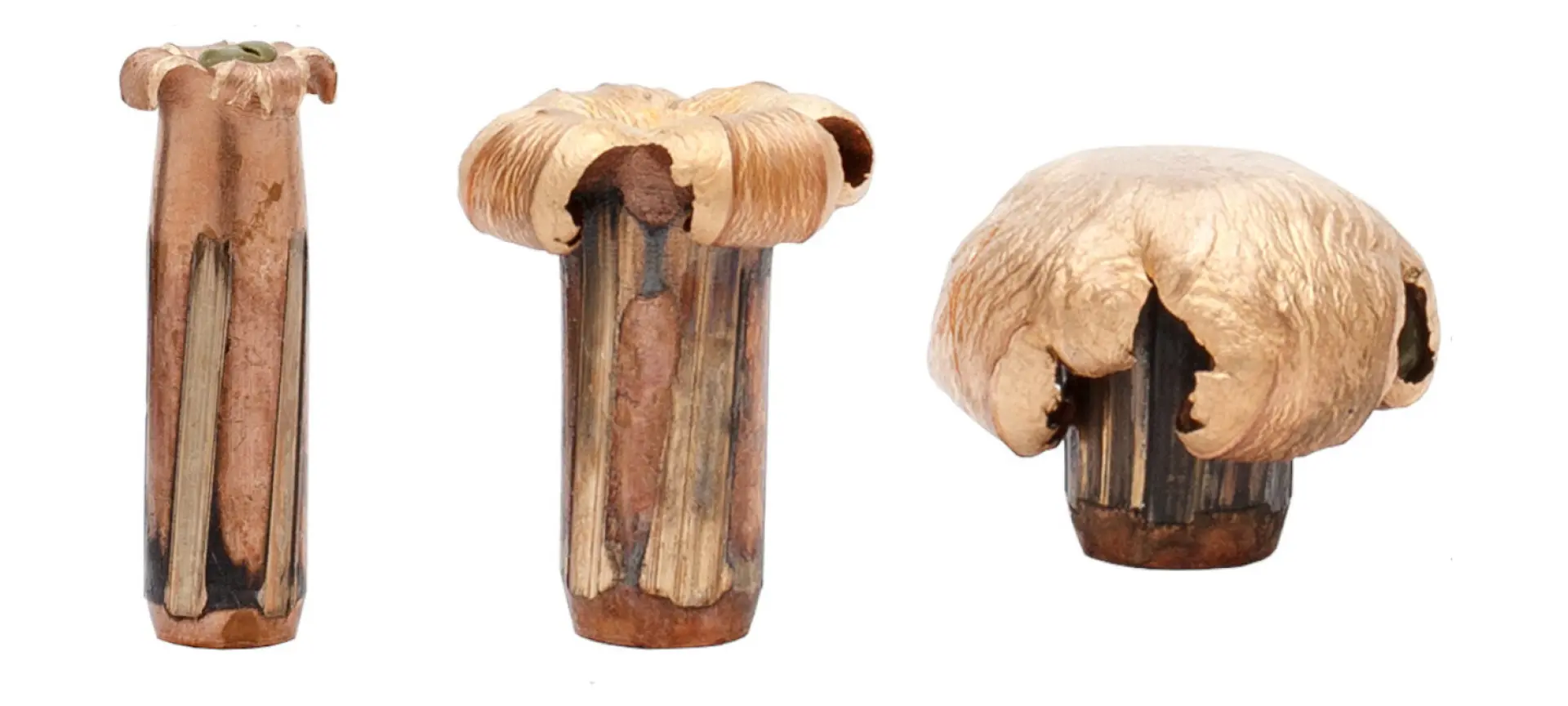In our series of tests on hunting ammunition, we have focused this time on the Expansion Tip bullet from the renowned manufacturer Nosler.
This bullet is intended for hunting larger and/or tougher game. In our context, this means mature wild boars and trophy-class deer, while abroad it is successfully used for hunting bears or robust African game. It maintains maximum weight retention (with the manufacturer claiming 95% or more) and features a high sectional density. Consequently, the relatively lower weight of the projectile compared to lead bullets does not significantly limit its terminal performance.
Prolonged Tuning
The manufacturer offers twenty variants of this bullet, specifically (diameter/weight): .224/55 gr, .243/90 gr, .257/100 gr, .264/120 gr, .277/130 gr, .284/140,150 gr, .308/110, 150,165,180 gr, .310/123 gr, .323/180 gr, .338/200, 225, 250 gr, .366/250 gr, and .375/260 gr. All options have a spitzer tip except for one "flat-nosed" exception weighing 150 gr, designed specifically for lever-action rifles chambered in .30-30, where pointed bullets cannot be used for safety reasons. This selection covers all commonly used calibers, including our traditional 7 mm, 8 mm, and 9.3 mm. For the purpose of this article, I tested the .264/120 gr variant in a Ruger American Predator bolt-action rifle chambered in 6.5 Creedmoor.

I managed to achieve a grouping at the edge of 1 MOA, but it required thorough effort during the reloading process.
At first and second glance, this bullet is very well manufactured and boasts negligible weight deviation. While I cannot speak for all configurations and rifles, it took me somewhat longer than usual to dial in the powder charge. Surprisingly, it didn’t "like" Swiss powder in the R60 variant, which is usually a reliable choice for achieving maximum accuracy. Out of nine different load configurations, I achieved the best results with a charge of 42.5 gr of Vectan SP11 powder and an overall cartridge length of 71 mm, which is slightly below the standard.
The chronograph recorded an average velocity of 869 m/s with muzzle energy of 2,935 J. As for groupings, I repeatedly managed to shoot five rounds into a circle measuring 26 mm at 100 meters, which is just under 1 MOA (averaged over two sets, excluding the worst shot, and measured center-to-center). In general, this is more than a respectable grouping, suitable even for long-range hunting. However, I admit I expected slightly better results.
My rifle has achieved groupings approaching 0.5 MOA with certain other bullets, and some users report that they have reached this level with the E-Tip as well. Considering the slightly more complex tuning process, I suspect that my Predator (with a barrel twist rate of 1:8") simply did not pair well with this bullet. Therefore, results with another rifle could be significantly better. I believe the bullet is simply a bit more finicky about the platform in which it performs optimally.
Even at Longer Distance
During the reloading process, apart from the above-mentioned need for more precise tuning, I didn’t encounter any significant complications. The tip is sturdy enough not to deform during normal or rough handling, or from impacts against the interior of the magazine due to recoil during shooting. However, I must mention slightly increased fouling of the bore that I observed. If you fire around 80 rounds at the range, it becomes somewhat noticeable compared to bullets like FOX, which are made from a different material, or Hasler bullets with ribs that reduce contact between the bullet and the bore. In typical hunting scenarios, this is unlikely to be a concern worth noting.
The Expansion Tip, being a long monolithic bullet, has a very favorable ballistic coefficient. In my case, it measured 0.497 BC, which ensures a flatter trajectory and slower velocity loss. The bullet is designed to perform well at high impact velocities. A minimum impact velocity of 550 m/s is recommended, while there is practically no upper limit. This is advantageous in situations where the shot is taken at close range, which usually results in greater tissue destruction. The E-Tip is less likely to suffer from this effect. Below the required minimum impact velocity for proper deformation, my bullet only drops to this threshold at a distance of 575 meters, where it still retains about 1,130 J of energy. This means the bullet also has significant potential for long-range hunting.

Although it’s not a true all-purpose bullet, the E-Tip expands appropriately when shot through the shoulder, even on lighter, thin-skinned game.
Factory Ammunition
Those who don’t reload their own ammunition don’t need to worry—Nosler has thought of them too, releasing a range of factory cartridges loaded with E-Tip bullets. This includes 35 different cartridges in calibers ranging from .223 Rem up to .375 H&H Magnum, including European classics like 6.5x55 mm, 7x57 mm, 8x57JS, and 9.3x62 mm. Considering the price of the bullets, the cartridges are relatively reasonably priced; for example, the .308 Win/168 gr variant costs 62 CZK per cartridge (sold in boxes of 20). The cartridges are proverbially well-made, as one would expect from Nosler. However, the performance could be slightly higher. For example, the 6.5 Creedmoor cartridge with a 120 gr bullet achieves a muzzle velocity of 870 m/s from a 610 mm barrel, which isn’t bad, but leaves room for improvement. Nosler factory ammunition is sold by several retailers in the Czech Republic, such as PROARMS CZ (proarms.cz).

A box of Nosler .308/150 gr factory cartridges loaded with Expansion Tip bullets.
How Does It Perform in Hunting?
Now that we’ve covered the technical details, it’s time to look at how the bullet performs in hunting. I had the opportunity to test it on a few adult wild boars (though none were trophy specimens), and the results were, in short, excellent. In terms of deformation potential, the bullet is quite remarkable. With most monolithic bullets, it is advised to aim for the animal’s shoulder, where the bullet can properly deform to achieve adequate terminal effect. The E-Tip, however, is one of the few monolithic bullets that can be used with classic lung-area shots, delivering a reasonable balance between terminal effect and meat preservation. On the other hand, shooting through the shoulder results in slightly higher tissue damage compared to what is typical for monolithic bullets.
While the bullet is designed for heavier game, I am convinced that even roe deer, when hit through the shoulder, will result in adequate deformation. I tested this theory, and the results can be seen in the photograph. The shot was taken at approximately 100 meters, with the game dropping on the spot, and the level of tissue destruction was reasonable. Again, a limited sample size, but it clearly works this way as well. In all my tests, the bullet consistently penetrated through the game, leaving no residue in the meat. Interestingly, I tried to catch the bullet at the range by shooting into a bundle of paper, a method that has worked well in the past, but the E-Tip eluded capture. Its penetration capability is, quite simply, exceptional.
Returning to practical hunting scenarios: the shooting distances I tested ranged from 55 to 180 meters, resulting in the immediate collapse of the game at the shot. It’s worth noting that these were ideal shots, hitting both the heart and lungs. I was satisfied with the performance, though, as always, it should be noted that the testing was limited in sample size, both in the number of animals harvested and the caliber/rifle used. That said, my findings align well with the reputation of Nosler’s green-tipped bullets among other hunters.
In Conclusion
What can we say in conclusion? The Expansion Tip is undoubtedly an excellent bullet. As a monolithic design, it poses no risk of meat or hunting area contamination with lead. Subjectively, I would describe it as somewhat finicky and therefore more demanding in terms of load tuning, but it has great potential, particularly for hunting larger game. Its penetration capability and weight retention are truly outstanding for such purposes. The deformation capability is relatively high for a monolithic bullet, yet it does not break apart when used at extremely short ranges. This gives hunters greater flexibility in shot placement, and the E-Tip can even be used on smaller game when shooting through the shoulder. However, for routine culling hunts, most hunters might reconsider due to the high cost of these bullets. The .224/55 gr variant costs 24.4 CZK per bullet, the tested .264/120 gr costs 36.1 CZK per bullet, the .308/150 gr costs 39.2 CZK per bullet, and the most expensive version, .375/260 gr, is priced at 48.8 CZK per bullet (commonly sold in boxes of 100). As a specialty bullet for trophy deer, it is ideal and works excellently on large wild boars in our region. Naturally, it also makes an excellent choice for hunters venturing abroad to hunt larger game outside the Czech Republic.

Examples of deformation of E-Tip .308/150 gr bullets depending on impact velocity. From left: 549 m/s, 732 m/s, and 945 m/s.
Advantages/Disadvantages
+ High quality
+ Adequate deformation even at high velocities
+ Lead-free construction
+ Expands even without hitting bone
- More demanding tuning process
- High purchase cos
Nosler Expansion Tip bullets can be purchased at the STROBL.CZ store. For more information, visit strobl.cz or the manufacturer's website at nosler.com.














